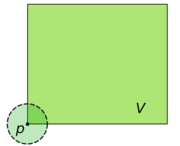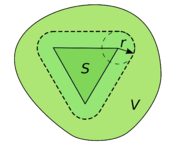
Neighbourhood (mathematics)
Encyclopedia


Topology
Topology is a major area of mathematics concerned with properties that are preserved under continuous deformations of objects, such as deformations that involve stretching, but no tearing or gluing...
and related areas of mathematics
Mathematics
Mathematics is the study of quantity, space, structure, and change. Mathematicians seek out patterns and formulate new conjectures. Mathematicians resolve the truth or falsity of conjectures by mathematical proofs, which are arguments sufficient to convince other mathematicians of their validity...
, a neighbourhood (or neighborhood) is one of the basic concepts in a topological space
Topological space
Topological spaces are mathematical structures that allow the formal definition of concepts such as convergence, connectedness, and continuity. They appear in virtually every branch of modern mathematics and are a central unifying notion...
. Intuitively speaking, a neighbourhood of a point is a set containing the point where you can move that point some amount without leaving the set.
This concept is closely related to the concepts of open set
Open set
The concept of an open set is fundamental to many areas of mathematics, especially point-set topology and metric topology. Intuitively speaking, a set U is open if any point x in U can be "moved" a small amount in any direction and still be in the set U...
and interior
Interior (topology)
In mathematics, specifically in topology, the interior of a set S of points of a topological space consists of all points of S that do not belong to the boundary of S. A point that is in the interior of S is an interior point of S....
.
Definition
If is a topological space
is a topological spaceTopological space
Topological spaces are mathematical structures that allow the formal definition of concepts such as convergence, connectedness, and continuity. They appear in virtually every branch of modern mathematics and are a central unifying notion...
and
 is a point in
is a point in  , a neighbourhood of
, a neighbourhood of  is a set
is a set  , which includes an open set
, which includes an open setOpen set
The concept of an open set is fundamental to many areas of mathematics, especially point-set topology and metric topology. Intuitively speaking, a set U is open if any point x in U can be "moved" a small amount in any direction and still be in the set U...
 containing
containing  ,
,
This is also equivalent to
 being in the interior of
being in the interior of  .
.Note that the neighbourhood
 need not be an open set itself. If
need not be an open set itself. If  is open it is called an open neighbourhood. Some authors require that neighbourhoods be open, so it is important to note conventions.
is open it is called an open neighbourhood. Some authors require that neighbourhoods be open, so it is important to note conventions.A set which is a neighbourhood of each of its points is open since it can be expressed as the union of open sets containing each of its points.
The collection of all neighbourhoods of a point is called the neighbourhood system at the point.
If
 is a subset
is a subsetSubset
In mathematics, especially in set theory, a set A is a subset of a set B if A is "contained" inside B. A and B may coincide. The relationship of one set being a subset of another is called inclusion or sometimes containment...
of
 then a neighbourhood of
then a neighbourhood of  is a set
is a set  which includes an open set
which includes an open set  containing
containing  . It follows that a set
. It follows that a set  is a neighbourhood of
is a neighbourhood of  if and only if it is a neighbourhood of all the points in
if and only if it is a neighbourhood of all the points in  . Furthermore, it follows that
. Furthermore, it follows that  is a neighbourhood of
is a neighbourhood of  iff
iffIFF
IFF, Iff or iff may refer to:Technology/Science:* Identification friend or foe, an electronic radio-based identification system using transponders...
 is a subset of the interior
is a subset of the interiorInterior (topology)
In mathematics, specifically in topology, the interior of a set S of points of a topological space consists of all points of S that do not belong to the boundary of S. A point that is in the interior of S is an interior point of S....
of
 .
.In a metric space

Metric space
In mathematics, a metric space is a set where a notion of distance between elements of the set is defined.The metric space which most closely corresponds to our intuitive understanding of space is the 3-dimensional Euclidean space...
 , a set
, a set  is a neighbourhood of a point
is a neighbourhood of a point  if there exists an open ball with centre
if there exists an open ball with centre  and radius
and radius  , such that
, such that
is contained in
 .
. is called uniform neighbourhood of a set
is called uniform neighbourhood of a set  if there exists a positive number
if there exists a positive number  such that for all elements
such that for all elements  of
of  ,
,
is contained in
 .
.For
 the
the  -neighbourhood
-neighbourhood  of a set
of a set  is the set of all points in
is the set of all points in  which are at distance less than
which are at distance less than  from
from  (or equivalently,
(or equivalently, 
 is the union of all the open balls of radius
is the union of all the open balls of radius  which are centred at a point in
which are centred at a point in  ).
).It directly follows that an
 -neighbourhood is a uniform neighbourhood, and that a set is a uniform neighbourhood if and only if it contains an
-neighbourhood is a uniform neighbourhood, and that a set is a uniform neighbourhood if and only if it contains an  -neighbourhood for some value of
-neighbourhood for some value of  .
.Examples
Given the set of real numberReal number
In mathematics, a real number is a value that represents a quantity along a continuum, such as -5 , 4/3 , 8.6 , √2 and π...
s
 with the usual Euclidean metric and a subset
with the usual Euclidean metric and a subset  defined as
defined as
then
 is a neighbourhood for the set
is a neighbourhood for the set  of natural number
of natural numberNatural number
In mathematics, the natural numbers are the ordinary whole numbers used for counting and ordering . These purposes are related to the linguistic notions of cardinal and ordinal numbers, respectively...
s, but is not a uniform neighbourhood of this set.
Topology from neighbourhoods
The above definition is useful if the notion of open setOpen set
The concept of an open set is fundamental to many areas of mathematics, especially point-set topology and metric topology. Intuitively speaking, a set U is open if any point x in U can be "moved" a small amount in any direction and still be in the set U...
is already defined. There is an alternative way to define a topology, by first defining the neighbourhood system, and then open sets as those sets containing a neighbourhood of each of their points.
A neighbourhood system on
 is the assignment of a filter
is the assignment of a filterFilter (mathematics)
In mathematics, a filter is a special subset of a partially ordered set. A frequently used special case is the situation that the ordered set under consideration is just the power set of some set, ordered by set inclusion. Filters appear in order and lattice theory, but can also be found in...
 (on the set
(on the set  ) to each
) to each  in
in  , such that
, such that
- the point
 is an element of each
is an element of each  in
in 
- each
 in
in  contains some
contains some  in
in  such that for each
such that for each  in
in  ,
,  is in
is in  .
.
One can show that both definitions are compatible, i.e. the topology obtained from the neighbourhood system defined using open sets is the original one, and vice versa when starting out from a neighbourhood system.
Uniform neighbourhoods
In a uniform spaceUniform space
In the mathematical field of topology, a uniform space is a set with a uniform structure. Uniform spaces are topological spaces with additional structure which is used to define uniform properties such as completeness, uniform continuity and uniform convergence.The conceptual difference between...
 ,
,  is called a uniform neighbourhood of
is called a uniform neighbourhood of  if
if  is not close
is not closeCloseness (mathematics)
In topology and related areas in mathematics closeness is one of the basic concepts in a topological space. Intuitively we say two sets are close if they are arbitrarily near to each other...
to
 , that is there exists no entourage containing
, that is there exists no entourage containing  and
and  .
.Punctured neighbourhood
A punctured neighbourhood of a point (sometimes called a deleted neighbourhood) is a neighbourhood of
(sometimes called a deleted neighbourhood) is a neighbourhood of  , without
, without  . For instance, the interval
. For instance, the intervalInterval (mathematics)
In mathematics, a interval is a set of real numbers with the property that any number that lies between two numbers in the set is also included in the set. For example, the set of all numbers satisfying is an interval which contains and , as well as all numbers between them...
 is a neighbourhood of
is a neighbourhood of  in the real line
in the real lineReal line
In mathematics, the real line, or real number line is the line whose points are the real numbers. That is, the real line is the set of all real numbers, viewed as a geometric space, namely the Euclidean space of dimension one...
, so the set
 is a punctured neighbourhood of
is a punctured neighbourhood of  . Note that a punctured neighbourhood of a given point is not in fact a neighbourhood of the point. The concept of punctured neighbourhood occurs in the definition of the limit of a function.
. Note that a punctured neighbourhood of a given point is not in fact a neighbourhood of the point. The concept of punctured neighbourhood occurs in the definition of the limit of a function.

